| Here is the view at the main entrance. Once again, we had fundamentalist Christians demonstrating here. They held signs implying that we NAMM show attendees were sinners in need of saving. I think these are the same people who precede the Tournament of Roses Parade on New year's Day in Pasadena. |
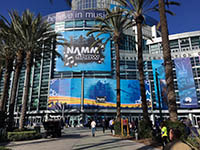 |
| As a sign (pun intended) of changing times, there are some new disallowed items this year at NAMM: hover boards and drones. Indeed, I did not see any of these inside - even in exhibits. |
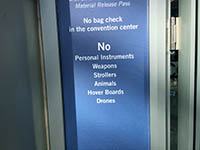 |
| I have noticed an increasing number of new instruments based on the steel drum paradigm. They are metal with regions you strike with mallets that produce different pitches. This new one from Idiopan is unique. At first glance, its distinct feature is the circular tone hole in the center. However - there is more to this than is visible. If you reach inside the hole, you can move magnets on each tone region to tune it over the range of about a half octave! This means you can retune the instrument to play different scales or chords. |
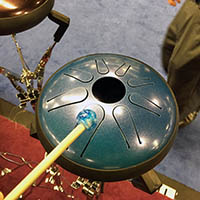 |
| This booth really catches your eye at the show. It is a display of percussion instruments from Freenotes Harmony Park. The odd thing is that their marimbas, chimes, congas, and xylophones are not arranged according to an traditional scale. Instead, they are grouped to make an artistic statement. The instrument being played by Karen here is arranged in an inverse pipe organ chest configuration with consecutive chromatic notes far from each other. I asked one of the exhibitors about this. She told me that most people "get the idea" pretty quickly and are quickly playing songs. I suggested that this might not be the case for musicians! |
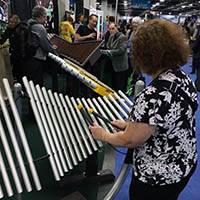 |
| This is a 24-string electric bass. However, the company running the booth, Kalium, does not make instruments - they make the strings. This was a novel way to show off the wide range of bass strings they manufacture. The bass DOES play though! It plays very well - though it is so heavy that it is usually mounted on a stand. |
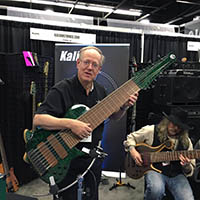 |
| Remember when you could buy many musical instruments as kits? My large home theater organ began life as one of those kits in the 1960s. Some kits are back again. According to the folks at the RAWKits booth, they are gaining quickly in popularity. Here is one of their electric guitar kits - all boxed and ready to be assembled. |
 |
| Soundbrenner was showing what it called "the first wearable device for musicians." It is not a musical instrument, however. It is a metronome. The wearable metronome, called the "Pulse," vibrates and flashes lights to indicate tempo. It can also make a sound - but this can be silenced for performances or recording sessions. You can control it from a mobile app or tap the tempo on the watch face. The most clever part is that if you own several, they can be synchronized in a local network. In this way all musicians at a recording session can use these instead of a click track. |
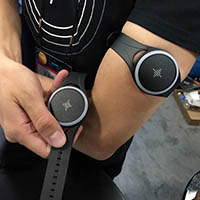 |
| Yamaha had a display of music-inspired sculpture in their huge exhibit. This is an interesting drum kit. It is not meant to be playable. |
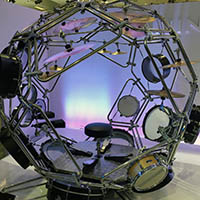 |
| The last several years have seen a large increase in mobile device applications to music. Some of these have been severely limited by the interface capabilities of the phones and pads. Here is what Mackie is doing. They have built a large audio interface system into which you slide your iPad. The iPad runs all the signal processing for a 16-channel mixer while the dedicated hardware takes care of all the connections. There is even a small interface to an iPhone to help control real-time changes at a performance or recording session. |
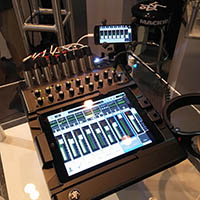 |
| When I saw this display, my initial reaction was disbelief. Why would anyone make brass mutes (in this case, mutes for trumpets and trombones) out of fine wood? After all, mutes are supposed to look beat-up, rusted, and dented. Every brass player has dropped and banged their mutes to a point where you would never show them off as art! I was also surprised to see the angled ends of the mutes - looking somewhat like stealth aircraft parts. These are made by Facet Mutes - a small privately-owned company that is apparently losing money in the process! The owner simply believes in his product. He had a trumpet at the booth so I tried about ten of the mutes. They played very well! Even the Harmon mute sounded right. The cup mutes come in several types of wood, each with a slightly different sound. They are not heavy - in fact they weigh about the same as their metal counterparts. The bevels are supposed to hep cancel sound waves within the mutes. I do not believe this is correct - but the mutes certainly work and sound great. |
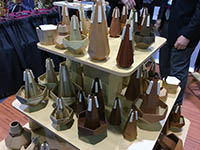 |
| This strange device is a plastic guard that fits onto a clarinet. It attaches with rubber rings at the joints in the sintrument. The guard can then be taken on and off very easily. It is for clarinet students so that they learn not to lift their fingers far from the keys while playing. |
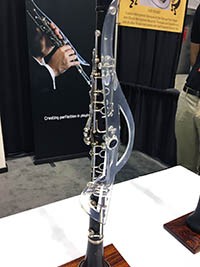 |
| In the category of strange new MIDI controllers (and a whole lot more, according to the salesman), here is the Du-Touch. Though it looks somewhat like a concertina keyboard, it is not. The buttons are in a slightly different configuration - and they can be reprogrammed. The base mode is set so that three consecutive keys play a major (or minor) triad. I found it somewhat confusing at first, but I was able to play a bit with it in only few minutes of experimentation. |
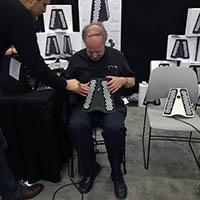 |
| Moog had an exhibit that was, perhaps, inspired by the California drought. It was a cactus garden. The plants are real. The hardest thing was that you had to sit on the floor to try their instruments! |
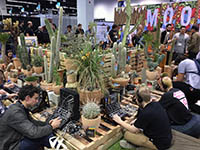 |
| Jinboa always has something interesting - and I have bought things here several times in the past. This thing doesn't have a name as far as I can tell. The woman at the booth didn't tell me what it was called - only its price! It is what I would call a contrabass valve trombone. I was able to play it with my tuba mouthpiece. |
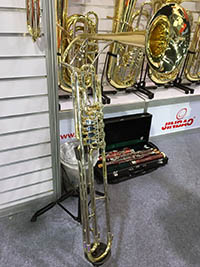 |
| I hate practicing drums using a practice pad. Perhaps if I had this one, it would help! It is basically five practice pads on a board. For some very strange reason, it is called a "QuadraPad!" I think Vic Firth needs to review its numbers. |
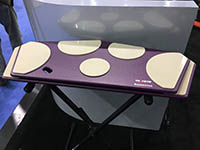 |
| Every year there are more plastic instruments. I showed a plastic tuba in my blog last year. This one, by Opus Instruments, is much better. It still had a dull response, but I could play all the notes pretty well in tune. The big advantage is that it is very light. |
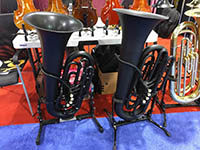 |
| As a pretty rotten drummer myself, I often do not know which kinds of sticks to use. This unique device, from Head Hunters solves my problem. Just play all of them at once! |
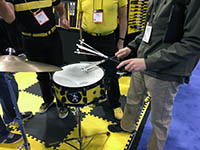 |
| My son turned out to be a jazz trumpet player. Perhaps it is because I took him to rehearsal with me when he was a toddler - and I didn't have one of these! These are ear muffs especially designed for babies and toddlers from Ems. They appear to be very comfortable. |
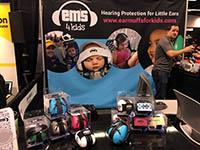 |
| This is a great idea with many applications. This company, called Remo Fingers, makes small wires with suction cups on the connectors. You stick them on a mobile device in a spot where you would use you finger to clock a control. The connector has a transducer that mimics the capacitance change of your finder. In this way, you can set up foot switches (or lots of other things) to trigger anything your finger can. They were pushing these a page turners for PDF viewers - but I think this kind of thing will find lots of other uses. |
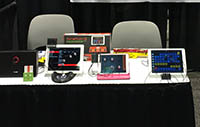 |
| This company, appropriately called Kool Max, makes sound systems built into picnic ice chests! This is just the thing for music at your barbecue. |
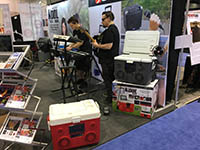 |
| As a musician who plays a lot in churches, this drum set should be just the thing. The Adoro company company in Germany has created this set specifically for performance in churches with reverberant acoustics. All the drums are scaled down in size and the pads are designed to have less kick-back. According to the designer, this has really taken off in Germany already, and they have a 20% market share there. |
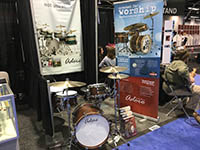 |
| ZVEX was showing this at their booth. It is billed as the world's first candle-powered effects box. It is truly remarkable. A small candle provides light to a set of solar cells. The electricity powers a small Sterling engine. The speed of the engine can be controlled by moving a dynamic braking device (a magnet) in near a flywheel. The engine turns a disk that has an offset opaque circle on it. The circle modulates a photo-detector which provides the phaser effect (its actually more of a tremolo) for a guitar (or anything else) that is played through it. |
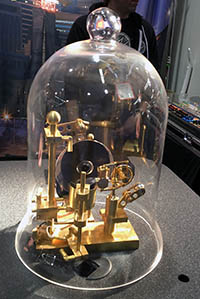 |
| Here is another new MIDI controller, the Zoom ARQ. |
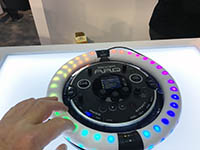 |
| And here is another, the LinnStrument. This one has 200 touch sensitive (including polyphonic aftertouch) buttons with programmable colored lights. It might make a great stop controller for virtual organs. At ~$1,400, that comes to $70 per switch. |
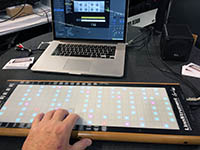 |
| I don;t know what they were selling at this booth, but they were playing OctaPong. It appears to be good old Pong with octopi added. I think you get extra points for killing off the octopi. |
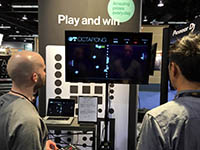 |
| Clearly the new Star Wars movie is still in everyone's mind. This Imperial TIE/LN starfighter appeared at the Pioneer DJ booth. |
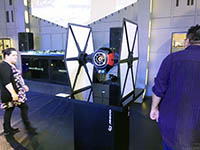 |
| KB Covers sells protective plastic overlays for Apple keyboards. This eye-catching display tells it all! For NAMM, they had a whole line of keyboard overlays designed for use with various studio software products. |
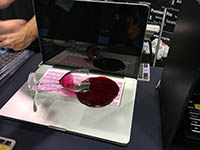 |
| Ploytec is selling a hardware duophonic analog synthesizer - but its only about an inch cubed and weighs less than my pet cockatiel. There are two of these Pi L Squared (They use Greek letters for Pi and Lambda) synths in this photo - just to the top right of the computer keyboard. These are also very inexpensive. |
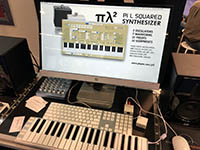 |
| Sound King displayed these monstrous-looking speaker enclosures at the entrance to their booth. |
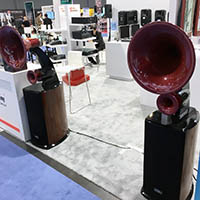 |
| And for the last entry – something I didn't think I'd be seeing at NAMM anymore: a graphaphone! For those who don't remember, this is a device that carves the modulations into record grooves. |
 |